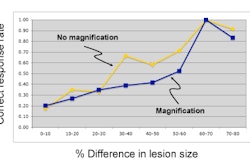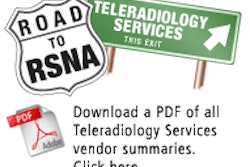Several years ago I wrote an article, titled "Avoiding the Beagle Approach to PACS," that included the statement about the way people seemed to pursue the PACS purchase process. It went: "When you give a beagle the scent of something, he just takes off. He pursues the goal relentlessly and single-mindedly. When he finally gets to the end of his search, he looks up, and he doesn't have any idea where he is."
I didn't own a beagle at the time, but now that I do I realize that they are poster children for attention-deficit hyperactivity disorder (ADHD). When I take Elvis for a walk, more often than not he'll see something and take off after it -- a squirrel, a bird, a lizard, basically anything that moves -- and becomes oblivious to everyone and everything around him.
The original intent of the walk only becomes apparent five minutes after we get back into the house, when he looks at me with sad eyes that say, "I knew there was something I had to do while I was out there and I, um, need to go back out again." If I don't take him out, I get baptismal water on my bookshelves, china cabinet, or anything else wooden (I can hear him now: "Hey, it was a tree once, so cut me some slack."), so out we go again.
In the five years since I wrote that article, most people's pursuit of PACS remains pretty much a beagle approach -- head down, not knowing where they are going, then complaining when they get there that they weren't where they expected to be and they forgot to do something while they were out. Part of that is their own fault, part of that is the vendor's fault, and part of that is the reliance on outside influences to help direct their path. It's also not so much what is said and heard in the evaluation process, but what is unsaid that makes a difference.
The good about PACS today
PACS software today in many respects is much better technologically than it was five years. Vendors are offering much more in terms of templating and specialized tools, as well as expanding into other areas such as orthopedics and cardiology.
Hardware has all but become commoditized, with virtually every vendor offering components from the same few players. While the vast majority of vendors still work in a Windows operating system environment, more vendors have begun to explore using Linux as their operating system of choice. The use of open-source software is also beginning to expand beyond DICOM viewing to include servers, archives, and other components. That said, the adoption of open-source PACS software remains extremely limited.
PACS adoption continues to increase at a rate of 15% to 20% per year, with large facilities (more than 400 beds) having the highest adoption rate (around 80%), and smaller facilities (less than 100 beds) having the lowest adoption rate (around 20%). This is mainly due to the smaller facilities needing to show a return on investment (ROI) with a three-year payback.
Smaller hospitals not only lack the required financial resources for a PACS implementation, but also lack information technology resources as well. Many also have older imaging modalities that may not support DICOM natively, which increases the costs further. This is why some have begun to look more closely at application service provider (ASP), fee for service (FFS), and other creative implementation options. This is also why smaller facilities have become a target market for a number of independent PACS vendors.
The replacement market constitutes about 25% of all PACS sales, and has created a new submarket as well -- data migration. Only a few vendors offer data migration services, but data migration is crucial to those replacing their PACS. Unfortunately, it is neither cheap nor fast to migrate data, as data more than three years old typically aren't in a format that migrates easily.
Pricing has also pretty much stabilized, with most vendors plus or minus 10% of each other when all is said and done. Doing an apples-to-apples comparison isn't any easier than it has been historically, but if you can get close you'll see that statement holds true.
It is also rare to find a facility that has to make the argument for PACS to its administration, outside of showing an ROI. PACS has proved its worth and value over the past decade, and has become an integral part of daily healthcare operations, improving efficiency, costs, and ultimately the quality of patient care. Finding adequate capital can still be a challenge, especially with smaller facilities, but creative options exist for those willing to seek them out.
The bad ... and the ugly
The adoption of initiatives like Integrating the Healthcare Enterprise (IHE) remains painfully slow, just as full DICOM adoption still remains an issue more than 20 years since its inception. It has been almost 10 years since the concept of IHE was first presented (although only three since it was actually demonstrated), yet a large percentage of the nearly 20 IHE integration profiles found within radiology remain to be adopted by most vendors.
Many of these, such as Key Image Notes (KIN) are crucial in archival applications, yet just a few vendors currently support these. Within the IHE initiative, HL7 has shown a much higher rate of adoption, yet we still see vendors inflating the interface tab by using custom-designed application program interfaces (APIs) instead of interface engines when it comes to interfacing RIS networks to PACS.
Vendor consolidation is beginning to happen, with some of the smaller independents falling by the wayside. Unfortunately, the stronger independents, with few exceptions, seem to be getting acquired by the bigger players and lose a lot of the charisma that initially attracted end users to them.
Vendor satisfaction rankings remain inconsistent, with a vendor rated No. 1 with one ratings organization while rated No. 10 with another. Case in point: acquisitions recently bolstered the largest PACS vendor from the No. 10 ranking to No. 1 virtually overnight in one poll. Of course, the product that vaulted them into the top spot is completely different than the prior offering, the price is about a third of its "other" PACS offering, and the service organizations are different, but the American way is if you can't earn the top spot, buy it … and so it goes.
Unfortunately, vendor ratings also remain the method that the vast majority of buyers use to identify which vendors to look at, with the four to five vendors ranked highest typically getting evaluated even though other solutions may be a better fit or weren't included in the ratings at all.
The entire PACS selection process still remains woefully inadequate, with both sides wasting inordinate amounts of time doing a do-si-do with multiple partners and finding out they are doing nothing but getting dizzy trying to understand it all instead of focusing on a much more graceful and rewarding pas de deux. This includes first-time buyers, as well as those buying replacement PACS.
The costs of responding to requests for proposals (RFPs) remains the same -- between $30,000 and $50,000 per response, win or lose. Generating an RFP also extends the time required to select a system by at least six months, with the net result rarely changing.
With each company's contract win rate averaging between 25% and 33%, that means $100,000 to $150,000 is being spent on each sale, and sales are taking a year or longer to consummate. If fewer players are involved and the success rate increases to 50%, $75,000 to $100,000 could be saved if the RFP savings are passed on to the end user and the costs brought down.
More sales would also be made in a shorter time frame. This requires changing the purchasing process and, unfortunately, the process isn't about to be changed for reasons that defy logic. Nearly every client I've worked with in the past five years has had a short list of two or three vendors that they seriously considered, yet most were required to solicit bids from at least five vendors "to ensure competitiveness." The list was almost always immediately pared to the two or three initially desired, but the "process" was adhered to and "fairness" demonstrated.
Albert Einstein and Ben Franklin have both been credited with this saying, but it certainly rings true here: "Insanity is doing the same thing over and over again and expecting different results."
Neither a standardized RFP format or industry lingo currently exists, with each vendor responding differently to the same identical question. The standardization of an RFP format and lingo would considerably lower costs and make performing an apples-to-apples vendor evaluation much easier and fairer.
Any cost savings made could be used to keep PACS companies afloat, since few are truly profitable despite statements made to the contrary. Only four dedicated PACS companies are publicly traded, with the rest private companies or major vendors whose PACS profits (or losses) aren't broken out from other divisions. No one really knows the viability of a company or division; we are asked to believe what we are told.
That is yet another area of concern -- corporate viability. In the past five years, more than 200 companies have come and gone in the PACS marketplace, leaving behind a trail of investments made and lost in systems. While the majors are seemingly immune from this, some of them are the worse offenders, regularly changing horses in midstream and leaving customers hanging. True, they didn't go belly up like their shallower-pocketed counterparts, but the impact on end users remains the same -- and no one got kissed either.
Vendor sales are also very inconsistent -- most claim to be up in total sales, yet down in net margins, with most in the negatives here. This is claimed to be due to higher discounting required to obtain sales relative to losses being faced by buyers due to the Deficit Reduction Act (DRA) of 2005, reductions in reimbursement, competition from other vendors, and other areas. But the reality is this is due to a lack of understanding about PACS from both the buyers and sellers jointly.
Integrated RIS/PACS solutions are still being offered, but are not nearly as strongly promoted as they were in years past. The arguments of a RIS-driven PACS or PACS-driven RIS have only served to confuse an already confused marketplace.
Interestingly, vendors that offer completely integrated solutions (PACS, RIS, C-PACS [cardiology], EMR, etc.) are being looked at a lot closer by chief information officers, chief technology officers, and IT departments at larger facilities than smaller independent players. The preservation of the investment made in PACS is key, and no facility wants a solution that cannot be expanded on.
In addition, the concept of a clinical patient record (CPR), clinical health record (CHR), and other related acronyms is advancing at a slow yet steady pace. The same can be said for regional health information organizations (RHIOs), community health information networks (CHINs), and others. As most mid to large hospital-based PACS usually are seven-digit investments, preserving this investment is key.
That's why facilities that have developed long-term plans for CPRs either select a vendor that can offer a wide variety of integrated products and services, or ensure that the system they are buying provides seamless and cost-effective integration with other clinical systems using industry standards. Some of the smaller independent PACS providers do a great job with integration, but the vast majority has no real defined or demonstrated plan of action, and instead hides under the guise of standards support, leaving it up to the facilities to do their own integration.
Along those same lines, many facilities are buying and supporting their own hardware. Turnkey solutions are still offered, notably by the majors, but the evolution of PACS into a commodity market is best demonstrated by the rise of smaller players that are all offering software-only solutions.
Very few facilities have an understanding of the requirements for both an archive and disaster recovery, with very few players in this field as well, although those that do currently play here have a good understanding of the requirements of end users. Most PACS vendors offer various archive options. Interestingly, most facilities are looking on a much broader scale toward developing a central data repository rather than having several different and costly archives working as islands of automation. Disaster recovery is often discussed, but what is offered is about as far away from being a true disaster recovery solution as I am from being considered the next American Idol.
A look into the future
Even though it seems the bad outweighs good in this story by a three-to-one margin (at least from a word count perspective), the future remains bright for PACS. The small (less than 200-bed) hospital market, which constitutes nearly seven out of 10 hospitals in the U.S., remains primed for growth, with fewer than one in five hospitals currently employing PACS. The replacement market is also solid, spurring new industries along the way.
Vendors will always come and go, but the shakeouts will end in a few years and the market will become a lot more stable from a vendor perspective. Second- and third-generation PACS users are helping to identify areas for improvement with the current systems, streamlining operations, and focusing on both functionality and form.
PACS is being looked at as much more than just a radiology system, as it has been in years past, and rightfully so. It serves as the backbone of an integrated information and image management network and has become not just an investment in radiology, but an investment in the future, serving the hospital, patients, and physicians alike. This will continue unabated despite all the obstacles thrown in its path. PACS no longer is an option for healthcare, but a requirement to compete in today's ever-growing and more competitive healthcare market.
By Michael J. Cannavo
AuntMinnie.com contributing writer
February 7, 2008
Michael J. Cannavo is a leading PACS consultant and has authored nearly 300 articles on PACS technology in the past 16 years. He can be reached via e-mail at [email protected].
The comments and observations expressed herein do not necessarily reflect the opinions of AuntMinnie.com, nor should they be construed as an endorsement or admonishment of any particular vendor, analyst, industry consultant, or consulting group. Rather, they should be taken as the personal observations of a guy who has, by his own account, been in this industry way too long.
References
"Avoiding the Beagle Approach to PACS," Michael J. Cannavo, Decisions in Imaging Economics, September 2002.
Related Reading
The 2007 PACSman Awards: Great expectations, November 29, 2007
Part XV: Exploring PACS Secrets -- The eHarmony approach, August 1, 2007
Part XIV: Exploring PACS Secrets -- Reading the fine print, March 12, 2007
The 2006 PACSman Awards: Of Chiclets and cappuccino, November 29, 2006
Copyright © 2008 AuntMinnie.com



















